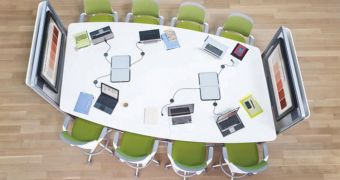Work flow efficiency experts say that it may be time to do away with the current setup most companies use. They add that the omnipresent cubicle should be removed from office floors and replaced with clusters of tables centered around mobile technologies and social services.
Tablets, smart phones, and social technologies should be made the center of attention in any modern work environment, experts say. Far fewer desks are actually needed today than the number that is in actual use, and this represents a massive waste.
These conclusions are based on a projective analysis of the quick expansion rate displayed by social and mobile technologies, which are causing the workforce to disperse, and be distributed more widely.
Similar redesigning experiments took place at times in the 1990s as well, but they failed. The reason for that is not that the idea itself was deficient, analysts say, but the fact that the technologies designers wanted to implement were not as advanced as they are today.
One good example of an advanced design is the headquarters iof San Jose, California- based Cisco Systems. The company replaced cubicles with a free, open space, that is largely populated by mobile desks. Rather than individuals, these desks are operated by groups.
What this means is that employees sit at a table where the people they need to work with are also staying. Others can move around from one desk to the other, and the desks themselves can be moved around the room – or be connected to each other – because they sit on wheels.
Rather than bulky computers, employees are using the Cius tablet, which they take with them at all times. All desks feature docking ports for the tablets, as well as smart phone docks, keyboards and monitors. This allows people to set up a working desk within minutes.
This setup enables fast data transfer between tablets, and is extremely efficient when it comes to organizing large or small office meetings. Personal items are largely confined to lockers, with the exception of necessary items.
Cisco also has its own social network, Quad, which can be accessed via the Internet, smart phones or tablets. Quad is used for voice calls, e-mail, instant messaging, updating the status of various projects, posting requests and answers and so on.
Officials at the company say that their transition to the new workspace came by after an internal study showed at least 67 percent of employees were not in their cubicles at any given time. The people were roaming about, talking to their colleagues or spread through campus.
The company is not by far the only one interested in reshaping the workplace. More and more employers are studying advanced ergonomics and efficiency studies, which indicate how to boost productivity without using an iron fist.
“We used to have boring stuff at work and more interesting technology at home. Now office technology will make use of the same cool experiences and interfaces,” Hewlett-Packard's research arm leader Prith Banerjee says, quoted by Technology Review.

 14 DAY TRIAL //
14 DAY TRIAL //